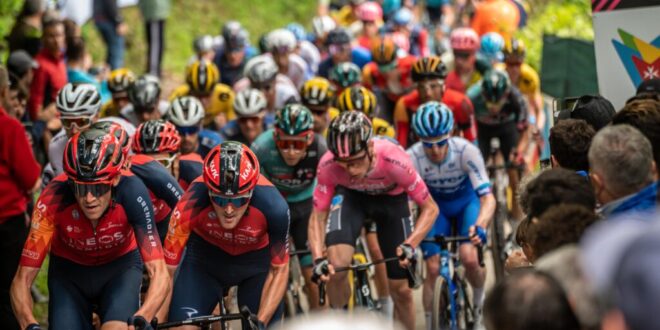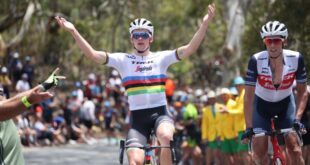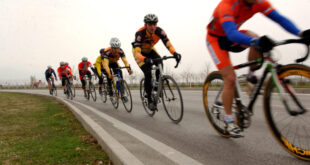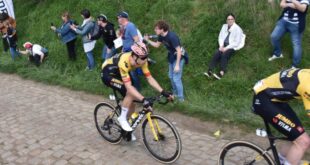Cyclists face the eighth stage of the giro d’italia. Credit: PhotoCG70 / Shutterstock.com
On the eve of the much-feared stage through the strade bianche of Siena, Australian rider Luke Plapp seized a dramatic solo victory in the eighth stage of the Giro d’Italia. The 23-year-old from Melbourne, born on Christmas Day 2000, attacked from the breakaway and defied a grueling course through the Sibillini mountains to cross the finish line alone in Castelraimondo.
It was a stage for opportunists and warriors alike, ridden at a relentless pace — averaging 50 kilometres per hour during the first hour alone — on undulating roads that carved their way from the Adriatic coast into the dark, forested interior. A stage of constant fatigue, riddled with steep climbs and merciless descents, where the peloton was tested from start to finish.
Plapp, a powerful time trialist not known for his tactical subtlety nor his expressive interviews, proved impervious to fatigue. As his rivals fell away, the breakaway group of 20 riders gradually thinned out until, with 45 kilometres to go, only Plapp remained. Behind him, veterans such as Romain Bardet, serial stage winner Diego Ulissi, and tireless workers like Wilco Kelderman could not respond. Among them, 22-year-old debutant Igor Arrieta, son of former pro and long-time directeur sportif José Luis Arrieta, fought valiantly before surrendering on the final climb of Gaglione, eventually finishing fourth.
Further back, UAE Team Emirates and Red Bull-Bora-Hansgrohe, the teams of Juan Ayuso and Primoz Roglic respectively, played a tactical game at the head of the peloton. Roglic, who wore the maglia rosa, appeared content to let others dictate the pace, while UAE alternated between pushing and holding back, seemingly unsure whether to defend or disrupt. In the end, the day belonged to Ulissi, who moved into the overall lead by a slender 17 seconds — taking the pink jersey from Roglic, who surrendered it for the second time in eight days.
Ulissi, now 35, adds the leader’s jersey to his illustrious Giro résumé, which includes eight stage victories since 2011. “It’s a dream for every Italian rider to wear the pink jersey,” said Pablo Lastras, runner-up to Ulissi in that first win 13 years ago.
For Roglic, the narrative is unsettlingly familiar. In 2019, he led the Giro during the opening week before losing the jersey on a breakaway stage and never reclaiming it. In contrast, when he won the 2023 edition, he wore pink for only one day — the final one, when it truly mattered.
Now all eyes turn to Sunday’s stage across the white gravel roads of Tuscany — a segment reminiscent of the iconic Strade Bianche one-day race. Lidl-Trek, with riders like Mads Pedersen and Mathias Vacek, are expected to set a punishing tempo capable of shredding the peloton on the climb up Santa Caterina into Siena’s historic Piazza del Campo — a battleground for cyclists, just as it is for the bareback riders of the Palio.
Juan Ayuso, who now sits just three seconds behind in the general classification, showed no intention of letting Roglic rest. He launched a late surge on the final incline in Castelraimondo, gaining a second and, perhaps more importantly, unnerving his Slovenian rival, whose heart rate reportedly spiked to 200 bpm.
The 22-year-old Spaniard admits to being anxious about the gravel stage. “Sunday will be incredibly tense,” he warned. “A mechanical, a small mistake, any little detail could undo months of hard work.” Roglic, at least on paper, boasts more experience on such terrain, having raced Strade Bianche three times between 2016 and 2017 — back when he was still a curiosity in the peloton, a former ski jumper learning to ride a bike.
Yet even then, he never found joy in the white roads, the ridges, or the cypress trees that stand like sentinels along the Tuscan tracks. Now, as the Giro tilts toward its most unpredictable terrain, the leader’s jersey remains anything but secure — and the battle for pink promises more chaos, more heartbreak, and more drama in the dust.
Read here more sports news.
 Costa News Spain Breaking News | English News in Spain.
Costa News Spain Breaking News | English News in Spain.





